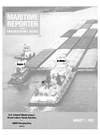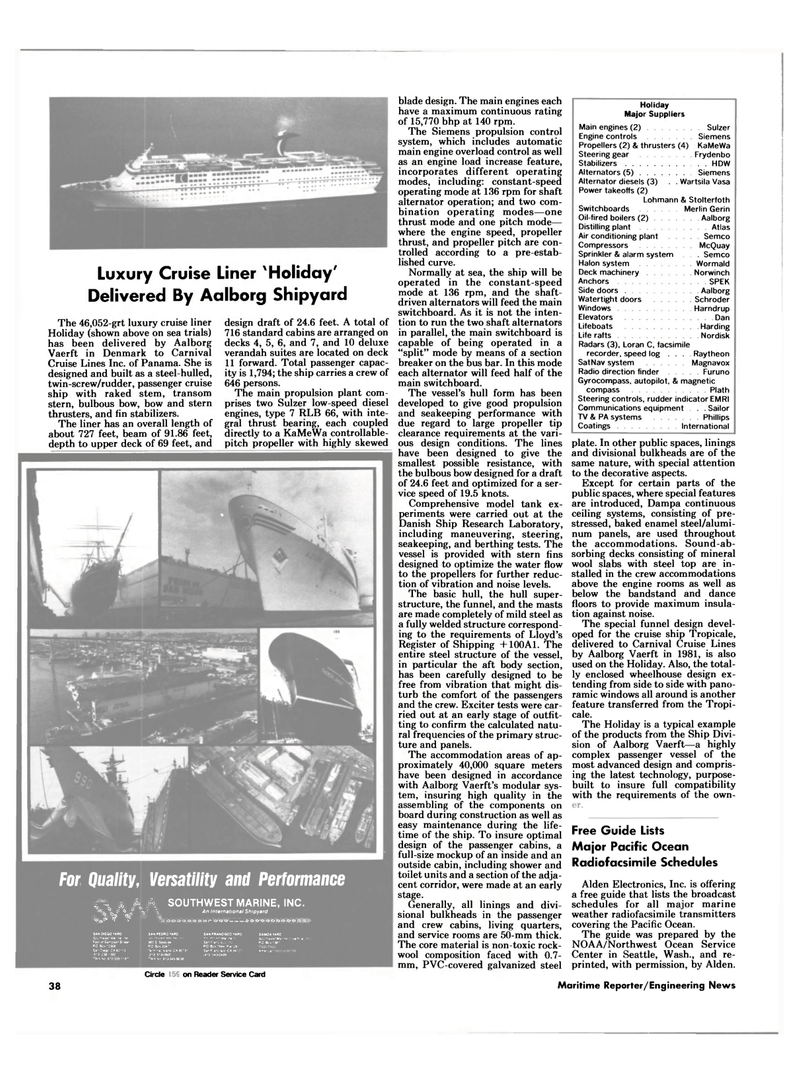
Page 40: of Maritime Reporter Magazine (August 1985)
Read this page in Pdf, Flash or Html5 edition of August 1985 Maritime Reporter Magazine
Luxury Cruise Liner 'Holiday'
Delivered By Aalborg Shipyard
The 46,052-grt luxury cruise liner
Holiday (shown above on sea trials) has been delivered by Aalborg
Vaerft in Denmark to Carnival
Cruise Lines Inc. of Panama. She is designed and built as a steel-hulled, twin-screw/rudder, passenger cruise ship with raked stem, transom stern, bulbous bow, bow and stern thrusters, and fin stabilizers.
The liner has an overall length of about 727 feet, beam of 91.86 feet, depth to upper deck of 69 feet, and design draft of 24.6 feet. A total of 716 standard cabins are arranged on decks 4, 5, 6, and 7, and 10 deluxe verandah suites are located on deck 11 forward. Total passenger capac- ity is 1,794; the ship carries a crew of 646 persons.
The main propulsion plant com- prises two Sulzer low-speed diesel engines, type 7 RLB 66, with inte- gral thrust bearing, each coupled directly to a KaMeWa controllable- pitch propeller with highly skewed
For Quality, Versatility and Performance & A A SOUTHWEST MARINE, INC.
SV¥ *
SAN CXEGO YARD Soufmts-Vw -K % An International Shipyard
II--^: :: T- ::: r~ ~ -V' Ul tf Q
SANPEoaO'AftO SANFAANCISCO *A«0 SAMOAMRO • - -- 1V, .--..I'M, - -.ft - cOC- Simpson St'««f
PO 8o« I33ce
SanOi«gc CA92H3 •6i9'238-'000
TWXNo 9'0-335-1'67 965 S ' ,. M, bo So, >30"
PO0O.1W* 9o, -6A. :e
VHMIAI CA90"3t CA9.I20 AM.- ci- (213 ,AiSlMM4»9
TWKNO 91»3A*-«63e
Circle 200 on Reader Service Card blade design. The main engines each have a maximum continuous rating of 15,770 bhp at 140 rpm.
The Siemens propulsion control system, which includes automatic main engine overload control as well as an engine load increase feature, incorporates different operating modes, including: constant-speed operating mode at 136 rpm for shaft alternator operation; and two com- bination operating modes—one thrust mode and one pitch mode— where the engine speed, propeller thrust, and propeller pitch are con- trolled according to a pre-estab- lished curve.
Normally at sea, the ship will be operated in the constant-speed mode at 136 rpm, and the shaft- driven alternators will feed the main switchboard. As it is not the inten- tion to run the two shaft alternators in parallel, the main switchboard is capable of being operated in a "split" mode by means of a section breaker on the bus bar. In this mode each alternator will feed half of the main switchboard.
The vessel's hull form has been developed to give good propulsion and seakeeping performance with due regard to large propeller tip clearance requirements at the vari- ous design conditions. The lines have been designed to give the smallest possible resistance, with the bulbous bow designed for a draft of 24.6 feet and optimized for a ser- vice speed of 19.5 knots.
Comprehensive model tank ex- periments were carried out at the
Danish Ship Research Laboratory, including maneuvering, steering, seakeeping, and berthing tests. The vessel is provided with stern fins designed to optimize the water flow to the propellers for further reduc- tion of vibration and noise levels.
The basic hull, the hull super- structure, the funnel, and the masts are made completely of mild steel as a fully welded structure correspond- ing to the requirements of Lloyd's
Register of Shipping + 100A1. The entire steel structure of the vessel, in particular the aft body section, has been carefully designed to be free from vibration that might dis- turb the comfort of the passengers and the crew. Exciter tests were car- ried out at an early stage of outfit- ting to confirm the calculated natu- ral frequencies of the primary struc- ture and panels.
The accommodation areas of ap- proximately 40,000 square meters have been designed in accordance with Aalborg Vaerft's modular sys- tem, insuring high quality in the assembling of the components on board during construction as well as easy maintenance during the life- time of the ship. To insure optimal design of the passenger cabins, a full-size mockup of an inside and an outside cabin, including shower and toilet units and a section of the adja- cent corridor, were made at an early stage.
Generally, all linings and divi- sional bulkheads in the passenger and crew cabins, living quarters, and service rooms are 50-mm thick.
The core material is non-toxic rock- wool composition faced with 0.7- mm, PVC-covered galvanized steel
Holiday
Major Suppliers
Main engines (2) . Sulzer
Engine controls Siemens
Propellers (2) & thrusters (4) KaMeWa
Steering gear Frydenbo
Stabilizers . . HDW
Alternators (5) Siemens
Alternator diesels (3) . . Wartsila Vasa
Power takeoffs (2)
Lohmann & Stolterfoth
Switchboards Merlin Gerin
Oil-fired boilers (2) . Aalborg
Distilling plant . . Atlas
Air conditioning plant . . . . Semco
Compressors McQuay
Sprinkler & alarm system . Semco
Halon system Wormald
Deck machinery Norwinch
Anchors . .SPEK
Side doors . Aalborg
Watertight doors Schroder
Windows Harndrup
Elevators . . .Dan
Lifeboats .Harding
Life rafts . Nordisk
Radars (3), Loran C, facsimile recorder, speed log ... Raytheon
SatNav system Magnavox
Radio direction finder . . . . Furuno
Gyrocompass, autopilot, & magnetic compass . . Plath
Steering controls, rudder indicator EMRI
Communications equipment . . Sailor
TV & PA systems . Phillips
Coatings International plate. In other public spaces, linings and divisional bulkheads are of the same nature, with special attention to the decorative aspects.
Except for certain parts of the public spaces, where special features are introduced, Dampa continuous ceiling systems, consisting of pre- stressed, baked enamel steel/alumi- num panels, are used throughout the accommodations. Sound-ab- sorbing decks consisting of mineral wool slabs with steel top are in- stalled in the crew accommodations above the engine rooms as well as below the bandstand and dance floors to provide maximum insula- tion against noise.
The special funnel design devel- oped for the cruise ship Tropicale, delivered to Carnival Cruise Lines by Aalborg Vaerft in 1981, is also used on the Holiday. Also, the total- ly enclosed wheelhouse design ex- tending from side to side with pano- ramic windows all around is another feature transferred from the Tropi- cale.
The Holiday is a typical example of the products from the Ship Divi- sion of Aalborg Vaerft—a highly complex passenger vessel of the most advanced design and compris- ing the latest technology, purpose- built to insure full compatibility with the requirements of the own-
Free Guide Lists
Major Pacific Ocean
Radiofacsimile Schedules
Alden Electronics, Inc. is offering a free guide that lists the broadcast schedules for all major marine weather radiofacsimile transmitters covering the Pacific Ocean.
The guide was prepared by the
NOAA/Northwest Ocean Service
Center in Seattle, Wash., and re- printed, with permission, by Alden. 38 Maritime Reporter/Engineering News

 39
39

 41
41
